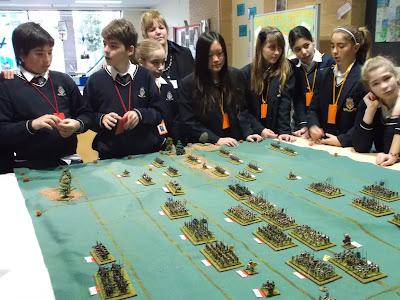To help our
secondary children in the school where I work to get to grips with history. In the September I offered my wargaming services to the history department, they enthusiastically took up my offer and wanted me to organise battles for the English Civil War and World War One. The objectives I made myself was that the game should be fun, fit into a single double lesson whilst
attempting to have 23 pupils , boys and girls participating at the same time and hopefully they should learn something along the way.
Royalists commanders for the second game.
The first game was the first lesson on a Monday morning so an early start was needed to prepare the table. The rules used were based on the free wargame rules Marston less by Tony Cullen . These used a grid sytem so it was easier to for the pupils to understand movement. I changed the rules for command, each side had a general for each horse and foot line and also higher commands for the centre and each wing (Oliver Cromwell, Prince Rupert etc). Each Pupil therefore had their own command to look after. I used the bucket of dice system and when there was combat several pupils (supports, line and generals) involved were able to throw dice.
All the pupils seemed to be engaged and having a good time.
Each pupil had a card around their neck explaining which units they were in charge of during the game. These were also colour coded red and orange to explain which side they were on.
The Majority of the girls were on the Roundhead side
On Monday we played the Royals actually won, after a see-saw infantry battle in the centre. The Parliament Commander-in-chief, Lord Fairfax was captured by the Royals when his second line was routed, although the Royals had lost their major General of foot Lord Astley when their front line had routed earlier on in the game. The cavalry on both wings were both engaged but without a decisive breakthrough on either flank.
The Royalist throwing their dice for combat, looks like the result was a good one.
For some reason I thought the lesson was ending
at half past ten instead of eleven and so wrapped the game up with a royalist victory because parliment had only 1 foot
unit on the table. I was able to make up the time however explaining what actually happened in the battle, and taking charge of a healthy question and answer session, mainly about Prince Rupert and his dog.
King Charles (second boy to the left) taking advice fron his generals.
On Thursday was the other Year 8 class, this
time I was more prepared and like the first game, the majority of the girls went on one side
(Parliament) and the boys the other side (Royalists). When I gave the
command cards out I got the players with higher commands to stand up and I
explained a little about their historical lives. This group were a lot more cautious, (on Monday there were lot of shouts of Attack,
attack) In the end I had to encourage the Royalists to move off there hill or
both sdes would have stayed there all day looking at eachother.
Birdseye view of the action.
The cavalry
under Rupert charged and the Royalist infantry advanced. The Parliament
infantry charged down the hill to meey the Royalist line. When the first foot line were engaged in combat
. King Charles finally decided (the boy playing Charles had the same charateristic of indecisiveness and listening to the last person who spoke.) to move into the melee to help reform the line. He was successful in removing the Disruption marker, but failed to fall back to safety. In the next combat
resolution the Royalist line broke and the King was captured causing the whole
of the Royal Army to be demoralised.
The Royalist Centre Command consider what to do next after losing their front line and the King.
On the right wing Prince Rupert
Another view from the gallery, I think at this time, I was explaining the importance of not moving your King into the combat area.
Prince Rupert charged with his second line but they were also routed and this time Rupert wasn't so lucky and was captured. Meaning Parliament had well and truly won the battle (and the war). I then explained what had actually happened and answered any questions they had. (one asked where he could buy the figures from and another asked about gaming World War 2).
A view from Parliament side, at this moment the Royalists still thought they had a chance of winning.
Afterwards I gave each Pupil a worksheet to choose another major battle, giving then four options Edgehill, Marston moor, Newbury and Cheriton . They have to research it and write a scenario to play with the same board and rules. Then the best ones will be picked out to played hopefully in a few weeks time.









No comments:
Post a Comment